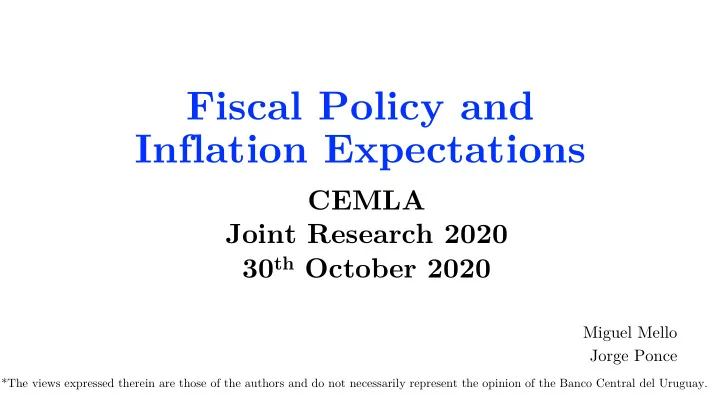

Fiscal Policy and Inflation Expectations CEMLA Joint Research 2020 30 th October 2020 Miguel Mello Jorge Ponce *The views expressed therein are those of the authors and do not necessarily represent the opinion of the Banco Central del Uruguay.
Motivation • Inflation expectations play a crucial role in an inflation target monetary regime. • Monetary authorities aim to anchor inflation expectations to the values that are tar- geted in order to ensure price stability. • Inflation expectations may be affected by fiscal, determining an interdependence between fiscal and monetary policies, different from the classical fiscal dominance argument. • Does fiscal policy affect inflation expectations made by price setters (i.e. firms)? • If it does, then fiscal policy can have an impact on monetary policy even in the absence of fiscal dominance (i.e. monetary financing of fiscal deficits).
Literature review • Sargent and Wallace (1981) introduce the distinction between monetary and fiscal dominance. • Licandro and Vicente (2006) analyze the link between fiscal policy and inflation objectives in Uruguay. • Bucacos (2020) applies De Resende’s (2007) methodology and finds no evidence of fiscal dominance in Uruguay. • Sims (2003) shows that agents update their expectations based on noisy information. • Coibion et al. (2018) shows that agents update their expectations after receiving new macroeconomic information. • Gelos and Rossi (2008) state the influence of fiscal variables over inflation expectations in Uruguay.
Contribution • We do an empirical study to assess the impact of fiscal policy outcomes on inflation expectations made by price setters in Uruguay. • We focus on inflation expectations of price setters instead of professional analysts. • We find robust empirical evidence of an interdependence between fiscal and monetary policies through inflation expectations by price setters in Uruguay. • Monetary policy faces more challenges to maintain inflation expectations anchored when the budget deficit worsen. • Nonetheless, monetary policy seems to be effective to compensate the distortions introduced by fiscal policy on inflation expectations.
Research Strategy • We estimate dynamic panel data models for price setters inflation expectations at the monetary policy horizon, using monetary and fiscal variables. • We estimate a baseline model that includes the most relevant and popular measurement of fiscal outcome (Budget deficit to GDP) and the monetary policy instrument. • Then we include in turn monetary authorities comunication to include the impact of this channel over expectations, and several interactions. • Then we check robusteness of our results using other fiscal variables and controlling for different macroeconomic variables.
The Data • Inflation expectations survey (IES). Ø 591 firms throughout the entire period covered by the sample: October 2009 to March 2020, monthly frequency, average response ratio of 77% with a minimum of 54%. Ø Representative of private non-financial, non-agricultural firms with 50 employees or more. Ø 3 different horizons: the current year, the next 12 months and the monetary policy horizon (18 months up to June 2013 and 24 months since then). Ø The resulting dataset is an unbalanced, long panel with a total of 126 months and 46,580 observations. • Fiscal and macroeconomic data Ø Budget deficit to GDP, FX depreciation and volatility, GDP growth, unemployment, etc. • Monetary contractivity index Ø Assess the tone of monetary policy communications by analyzing strings of 13 words around inflation and monetary policy .
Communicational Variable • Monetary Contractivity Index: • Monetary policy statements-COPOM. • Using web scraping and text analysis techniques we identify two target words inside each statement: inflation and monetary policy . • We selected and analyze strings of 13 words that contain one of our target words. • To characterize the tone of each string we assign a value between -2 and 2 to each one: Ø -2 means very expansive, Ø -1 is expansive, Ø 0 is neutral, Ø 1 is contractive, Ø 2 is very contractive. • The contractivity index of each monetary policy statement is computed as the simple average of the values assigned to the corresponding strings.
Monetary policy and fiscal deficit in Uruguay • Uruguay has an inflation targeting regime since 2007. • Two stages in terms of the monetary policy management instrument. Ø 2007 - June 2013: the interest rate was used as policy instrument. Ø July 2013 - nowadays: o The inflation target range was widened, from [4-6] to [3-7]. o Growth of monetary aggregates became the policy instrument. o The monetary policy horizon was extended, from 18 months to 24 months. • Inflation was rarely within the target range, however, there seems to be no substantive de-anchoring of expectations, as these are at high levels but relatively stable over time. • Budget deficit to GDP increased from 2,5% to 5.1% during the period analyzed.
Inflation and monetary policy
Inflation and inflation expectations
Monetary contractivity index
Budget deficit and primary deficit to GDP
Descriptive Statistics Variable Obs Mean Std. Dev. Min Max Expected inflation rate in t = H 46,580 8.95 2.06 5.00 25.00 Inflation rate 46,580 8.00 1.16 5.24 11.00 Short term interest rate 46,580 9.76 2.60 6.25 15.66 Budget deficit to GDP 46,580 2.98 1.30 0.44 5.11 Monetary contractivity index 46,580 0.28 0.29 -0.33 1.00 Awareness about monetary policy 46,580 0.20 0.40 0.00 1.00 FX depreciation 46,580 0.48 2.43 -5.11 13.93 FX volatility 46,580 0.10 0.19 0.00 1.78 GDP growth 36,062 2.79 2.09 -1.49 7.96 Unemployment rate 46,580 7.25 1.00 5.60 10.80
Recommend
More recommend